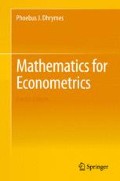Abstract
In this chapter, we examine the General Linear Model (GLM), an important topic for econometrics and statistics, as well as other disciplines. The term general refers to the fact that there are no restrictions in the number of explanatory variables we may consider, the term linear refers to the manner in which the parameters enter the model. It does not refer to the form of the variables. This is often termed in the literature the regression model, and analysis of empirical results obtained from such models as regression analysis.
Access this chapter
Tax calculation will be finalised at checkout
Purchases are for personal use only
Notes
- 1.
The term estimator recurs very frequently in econometrics; just to fix its meaning in this chapter and others we define it as: an estimator is a function of the data only (x′s and y′s), say h(y,X) that does not include unknown parameters.
- 2.
The term consistent generally means that as the sample, T, tends to infinity the estimator converges to the parameter it seeks to estimate. Since the early development of econometrics it meant almost exclusively convergence in probability. This is the meaning we shall use in this and other chapters, i.e. an estimator is consistent for the parameter it seeks to estimate if it converges to it in any fashion that implies convergence in probability.
- 3.
In the context of Eq. (10.79) the notation ∼ is to be read “behaves like”.
- 4.
Occasionally this test is referred to as a test of significance of R 2.
- 5.
The sample size is assumed to be the same for all firms.
Bibliography
Anderson, T.W. and H. Rubin (1949), Estimation of the Parameters of a Single Equation in a Complete System of Stochastic Equations, Annals of Mathematical Statistics, pp. 46–63.
Anderson, T.W. and H. Rubin (1950), The Asymptotic Properties of Estimates of Parameters of in a Complete System of Stochastic Equations, Annals of Mathematical Statistics, pp. 570–582.
Balestra, P., & Nerlove, M. (1966). Pooling cross section time series data in the estimation of a dynamic model: The demand for natural gas. Econometrica, 34, 585–612.
Bellman, R. G. (1960). Introduction to matrix analysis. New York: McGraw-Hill.
Billingsley, P. (1968). Convergence of probability measures. New York: Wiley.
Billingsley, P. (1995). Probability and measure (3rd ed.). New York: Wiley.
Brockwell, P. J., & Davis, R. A. (1991). Time series: Theory and methods (2nd ed.). New York: Springer-Verlag.
Chow, Y. S., & Teicher, H. (1988). Probability theory (2nd ed.). New York: Springer-Verlag.
Dhrymes, P. J. (1969). Alternative asymptotic tests of significance and related aspects of 2SLS and 3SLS estimated parameters. Review of Economic Studies, 36, 213–226.
Dhrymes, P. J. (1970). Econometrics: Statistical foundations and applications. New York: Harper and Row; also (1974). New York: Springer-Verlag.
Dhrymes, P. J. (1973). Restricted and Unrestricted Reduced Forms: Asymptotic Distributions and Relative Efficiencies, Econometrica, vol. 41, pp. 119–134.
Dhrymes, P. J. (1978). Introductory economics. New York: Springer-Verlag.
Dhrymes, P.J. (1982) Distributed Lags: Problems of Estmation and Formulation (corrected edition) Amsterdam: North Holland
Dhrymes, P. J. (1989). Topics in advanced econometrics: Probability foundations. New York: Springer-Verlag.
Dhrymes, P. J. (1994). Topics in advanced econometrics: Volume II linear and nonlinear simultaneous equations. New York: Springer-Verlag.
Hadley, G. (1961). Linear algebra. Reading: Addison-Wesley.
Kendall, M. G., & Stuart, A. (1963). The advanced theory of statistics. London: Charles Griffin.
Kendall M. G., Stuart, A., & Ord, J. K. (1987). Kendall’s advanced theory of statistics. New York: Oxford University Press.
Kolassa, J. E. (1997). Series approximation methods in statistics (2nd ed.). New York: Springer-Verlag.
Sims, C.A. (1980). Macroeconomics and Reality, Econometrica, vol. 48, pp.1–48.
Shiryayev, A. N. (1984). Probability. New York: Springer-Verlag.
Stout, W. F. (1974). Almost sure convergence. New York: Academic.
Theil, H. (1953). Estimation and Simultaneous Correlation in Complete Equation Systems, mimeograph, The Hague: Central Plan Bureau.
Theil, H. (1958). Economic Forecasts and Policy, Amsterdam: North Holland.
Author information
Authors and Affiliations
Rights and permissions
Copyright information
© 2013 the Author
About this chapter
Cite this chapter
Dhrymes, P.J. (2013). The General Linear Model. In: Mathematics for Econometrics. Springer, New York, NY. https://doi.org/10.1007/978-1-4614-8145-4_10
Download citation
DOI: https://doi.org/10.1007/978-1-4614-8145-4_10
Published:
Publisher Name: Springer, New York, NY
Print ISBN: 978-1-4614-8144-7
Online ISBN: 978-1-4614-8145-4
eBook Packages: Mathematics and StatisticsMathematics and Statistics (R0)

